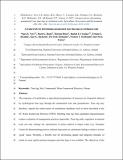| dc.contributor.author | Vero, Sara E. | |
| dc.contributor.author | Healy, Mark G. | |
| dc.contributor.author | Henry, Tiernan | |
| dc.contributor.author | Creamer, Rachel E. | |
| dc.contributor.author | Ibrahim, Tristan G. | |
| dc.contributor.author | Richards, Karl G. | |
| dc.contributor.author | Mellander, Per-Erik | |
| dc.contributor.author | McDonald, Noeleen T. | |
| dc.contributor.author | Fenton, Owen | |
| dc.date.accessioned | 2017-08-10T13:57:54Z | |
| dc.date.issued | 2016-12-10 | |
| dc.identifier.citation | Vero, Sara E., Healy, Mark G., Henry, Tiernan, Creamer, Rachel E., Ibrahim, Tristan G., Richards, Karl G., Mellander, Per-Erik, McDonald, Noeleen T., Fenton, Owen. (2017). A framework for determining unsaturated zone water quality time lags at catchment scale. Agriculture, Ecosystems & Environment, 236, 234-242. doi: http://dx.doi.org/10.1016/j.agee.2016.12.001 | en_IE |
| dc.identifier.issn | 0167-8809 | |
| dc.identifier.uri | http://hdl.handle.net/10379/6697 | |
| dc.description.abstract | The responses of waterbodies to agricultural programmes of measures are frequently delayed by hydrological time lags through the unsaturated zone and groundwater. Time lag may therefore, impede the achievement of remediation deadlines such as those described in the EU Water Framework Directive (WFD). Omitting time lag from catchment characterisation renders evaluation of management practices impossible. Time lag aside, regulators at national scale can only manage the expectations of policy-makers at larger scales (e.g. European Union) by demonstrating positive nutrient trajectories in catchments failing to achieve at least good status. Presently, a flexible tool for developing spatial and temporal estimates of trends in water quality/nutrient transport and time lags is not available. The objectives of the present study were first to develop such a flexible, parsimonious framework incorporating existing soil maps, meteorological data and a structured modelling approach, and to secondly, to demonstrate its use in a grassland and an arable catchment (~10 km2) in Ireland, assuming full implementation of measures in 2012. Data pertaining to solute transport (meteorology, soil hydraulics, depth of profile and boundary conditions) were collected for both catchments. Low complexity textural data alone gave comparable estimates of nutrient trajectories and time lags but with no spatial or soil series information. Taking a high complexity approach, coupling high resolution soil mapping (1:10,000) with national scale (1:25,000) representative profile datasets to | en_IE |
| dc.description.sponsorship | This research was funded by the Teagasc Walsh Fellowship
Scheme. | en_IE |
| dc.format | application/pdf | en_IE |
| dc.language.iso | en | en_IE |
| dc.publisher | Elsevier Masson | en_IE |
| dc.relation.ispartof | Agriculture Ecosystems & Environment | en |
| dc.rights | Attribution-NonCommercial-NoDerivs 3.0 Ireland | |
| dc.rights.uri | https://creativecommons.org/licenses/by-nc-nd/3.0/ie/ | |
| dc.subject | Time lag | en_IE |
| dc.subject | Soil | en_IE |
| dc.subject | Unsaturated | en_IE |
| dc.subject | Water Framework Directive | en_IE |
| dc.subject | Nitrate | en_IE |
| dc.subject | Civil engineering | en_IE |
| dc.title | A framework for determining unsaturated zone time lags at catchment scale | en_IE |
| dc.type | Article | en_IE |
| dc.date.updated | 2017-07-21T15:22:33Z | |
| dc.identifier.doi | 10.1016/j.agee.2016.12.001 | |
| dc.local.publishedsource | https://doi.org/10.1016/j.agee.2016.12.001 | en_IE |
| dc.description.peer-reviewed | peer-reviewed | |
| dc.contributor.funder | |~|1267880|~| | |
| dc.description.embargo | 2018-12-10 | |
| dc.internal.rssid | 11691550 | |
| dc.local.contact | Mark Healy, Room Eng-1038, Civil Engineering, Col Of Engineering & Informatics, Nui Galway. 5364 Email: mark.healy@nuigalway.ie | |
| dc.local.copyrightchecked | No | |
| dc.local.version | ACCEPTED | |
| nui.item.downloads | 392 | |


